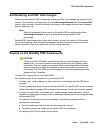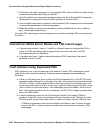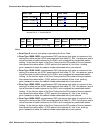
Communication Manager Maintenance-Object Repair Procedures
1862 Maintenance Procedures for Avaya Communication Manager 3.0, Media Gateways and Servers
3. At this point, the faulty component is on the standby PNC, and the PNCs are locked in their
current active/standby state. Busy-out the PNC.
4. Use fault isolation and component testing procedures for the individual PNC components.
Replacement of components will not disrupt operation of the active PNC.
5. Once the failed component is replaced, test the standby PNC component from the terminal
to ensure the replacement is functioning properly.
6. When the problem is resolved as indicated by a state of health with all zeros, (status
pnc), unlock and release the pnc.
No further PNC interchange is required because you can test the standby PNC as thoroughly as
the active.
Interactions: Media Server Resets and PNC Interchanges
● A system reset of level 1 (warm), 2 (cold2) or 4 (reboot) does not change which PNC is
active. If a PNC interchange was in progress when the reset took place, the PNC
interchange still goes to completion.
● If a system reset level 1 (warm) takes place during a PNC interchange, the reset is
escalated to level 2 (cold2).
Fault Isolation Using Duplicated PNC
PNC duplication, can, in some cases aid in the isolation of faults. PNC interchanges can be
used to help indict the faulty hardware. Following are two examples demonstrating this
technique.
● There is a fault which can occur in either an IPSI port network’s EI or the PKT-INT which
cannot be readily attributed to one board or the other. If the packet bus transceivers on the
PKT-INT or EI fail, it will be apparent that the two boards cannot communicate, but it will
not be clear which board is at fault. In this case, a planned interchange of the PNC can be
used to indict one of the two boards. If the interchange cures the problem, the EI was at
fault. If the interchange does not cure the problem, the PKT-INT is suspect, provided there
are no PKT-BUS faults.
● A similar relationship exists for the PN Archangel (active EI) and certain TDM bus
problems. If the EAA cannot communicate with a port board over the TDM bus, then the
EAA has a fault, the port board has a fault, or there is a problem with the TDM bus itself.
- If TDM bus maintenance tests find no problems with the bus, then it is either the port
board or the EAA. It may be simpler to replace the port board than to request a PNC
interchange.


















